How to Engage ELLs in Literary Conversations
By Larry Ferlazzo and Katie Hull Sypnieski
We provide our English Language Learners with the opportunity to read high-interest books independently. Literary conversations, both written and oral, help them interact with these texts while creating a classroom culture of shared literacy.
We apply these strategies primarily to independent reading books, but they can also be used with texts we are reading together as a class. (If you’d like to know more specifics about our independent reading approach, see Strategy 1 resources here.)
Why We Like These Conversation Tools
As we note in our new book The ELL Teacher’s Toolbox, the Literacy Conversations activities we share here all serve to encourage student investment in reading while they gain authentic writing and speaking practice.
In addition, the tools reinforce literary terms and concepts. We want our students to discuss their reading in meaningful and engaging formats, and not in dull recitations that feel obligatory, monotonous, or always tied to a grade.
The following activities provide students with the opportunity to share their reading in creative, fun ways. They also reflect how readers talk about books outside the classroom – we don’t know many people who write a book report every time they finish a book!
These ideas describe a few of the alternatives to traditional reading logs or book reports that we use in class. Many more can be found on the sites listed in Technology Connections (download now or at the end of this article). These activities can be modified for different English proficiency levels and can either incorporate technology or be done as “low tech” versions.
Book Trailers
Book Trailers are an engaging way to help students write and talk about their reading. This strategy also invites students to practice elements of argumentation as they present a claim and back it up with specific reasons and evidence.
The teacher can begin by showing students some examples of book trailers (see Technology Connections) and asking students to write down what these examples have in common. The teacher might ask, “Do they summarize the whole book or just describe some elements of the story?” “Do they offer reasons why someone should read the book?” “How do the images appeal to readers?”
After studying the examples, students then choose a favorite book and begin creating their own trailer. The teacher can give students a handout listing the elements that the Book Trailer must include (See Figure 2.1 “Book Trailer” for an example) or the teacher and students can come up with a list together.
Students can do a low-tech version by displaying their book while they read their “trailer” in front of the class, in small groups, or when visiting another classroom to share. They could also create a book trailer poster (similar to a movie poster) with the title, main characters’ names, images representing the story, and/or a rating (e.g. five stars). Students could then display their posters and take turns sharing their book trailers in small groups or as a class.
Creating digital book trailers can be even more engaging for students and create a “living” archive where students can go for inspiration. There are several great tools students can use to create digital book trailers (see Technology Connections).
Book Talks
Book Talks are another great way for students to interact with their reading and gain valuable speaking practice. The teacher can give students questions to answer about the books they are reading (e.g. Why did you choose this book? What do you like about this book? Why should another student read this book?). Students answer the questions in writing and then use them to do a “Book Talk” with a partner, in a small group, or for the whole class. We would recommend doing one or two a day, rather than having students listen to thirty book talks in a row! (See Figure 2.2 “Book Talk” for an example of the directions we give to students).
This activity allows classmates to hear about other interesting books their classmates are reading and helps to build a classroom culture of shared literacy.
Partner Reading
Reading self-selected books in pairs is another activity which builds engagement in literacy. It provides student choice; reading, speaking, listening, and writing practice; an authentic audience; and immediate feedback.
Once a week in our combined Beginner/Intermediate class, students “pair up”— primarily, but not exclusively, with one Beginner and one Intermediate (we have found that pairing students up in this way is less frustrating for the Beginner and more confidence-boosting for the Intermediate). We post the “Partner-Reading Instructions” (see Figure 2.3 “Partner-Reading Instructions”) and students are given a couple of minutes to choose a book.
Then we explain to students they will read one paragraph at a time aloud to each other. After reading (we usually give students about 10 minutes of reading time), they choose three new words they encountered, write them down on a piece of paper, and learn what they mean. In addition, they draw a picture that represents what they read, and write a sentence which explains why they liked or didn’t like the book. Students then can either present to groups of other students and/or we record their presentation using one of many apps (see Technology Connections).
Book Interviews
Book Interviews are another way for students to interact with the books that they and their classmates are reading. In this activity, students work in pairs to interview each other about the books they are currently reading. We give students the Book Interview form (Figure 2.4 “Book Interview”) where they can take notes as they ask their partner questions about his/her book.
The teacher can create the questions for the form or students can come up with their own. After partners are finished interviewing each other, they can use their notes to prepare a short presentation about their partner’s book which they can present to the class or in small groups, or record them to post on a class blog.
“Golden Lines”
This activity, which we were first introduced to by the WRITE Institute, can be used to instantly generate student thinking, writing, and discussion about their reading.
It involves students reading a text and identifying a “golden line”—a sentence that is surprising, descriptive, thought-provoking, meaningful, etc. Students can copy this golden line onto a piece of paper and write why they selected it. Sometimes we have students illustrate it as well.
Then students share their golden lines with each other in pairs, small groups, or as a class. They can also be posted on the classroom wall or shared online.
Creative Response Prompts
Traditional reading strategies like making a prediction, asking a question, summarizing, etc. are obviously important for students to practice. However, when we want to “spice things up,” we’ll provide students with more creative response prompts. We’ve found these types of prompts result in more intrinsically motivating reading responses and sharing among our students while building higher-order thinking. The following prompts include some of the possibilities:
Plot Twist: Choose a part of the book you have read and explain how you would change the story. Why would you make these changes?
Be a Therapist: Give advice to one of the book’s characters. What would you tell him or her to do, and why?
Dear Diary: Pick a character from your book and write an entry in his or her diary.

Trading card: Choose a character and make a trading card. On one side draw a picture of the character and on the other side write important facts and traits about this character.
Rename it: Write a new title for your book and explain why you chose this title.
What if?: Write a question about your book that begins with “What if?” (for example, in The Hunger Games “What if Katniss didn’t volunteer as a tribute?”) and then write a response to your question.
Some of the prompts above were modified from a list by Ross Cooper (2015).
What Could Go Wrong?
As we stated earlier, these activities represent alternatives to required reading logs which often squash student interest in reading. However, even engaging, meaningful activities can become rote or less motivating when tied to external motivators (i.e. grades, rewards, mandates). Keeping the end goal of creating life-long readers in mind means balancing accountability with choice and recognizing individual students’ circumstances.
Some teachers may be hesitant to ask their Beginning level students to have literary conversations. However, our Beginners have been able to do so with modifications such as drawing and sharing pictures about their books and using teacher-provided sentence stems (like the ones on Figure 2.4 “Book Interview”) to scaffold book discussions.
Download Technology Connections, Supporting Research,
and Common Core Connections for this article.


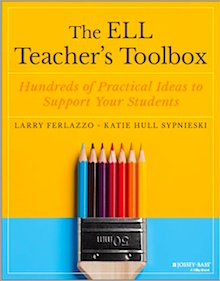

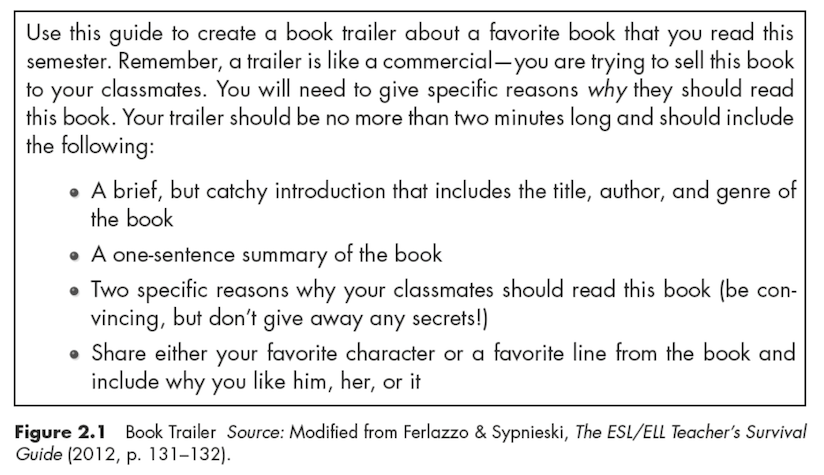
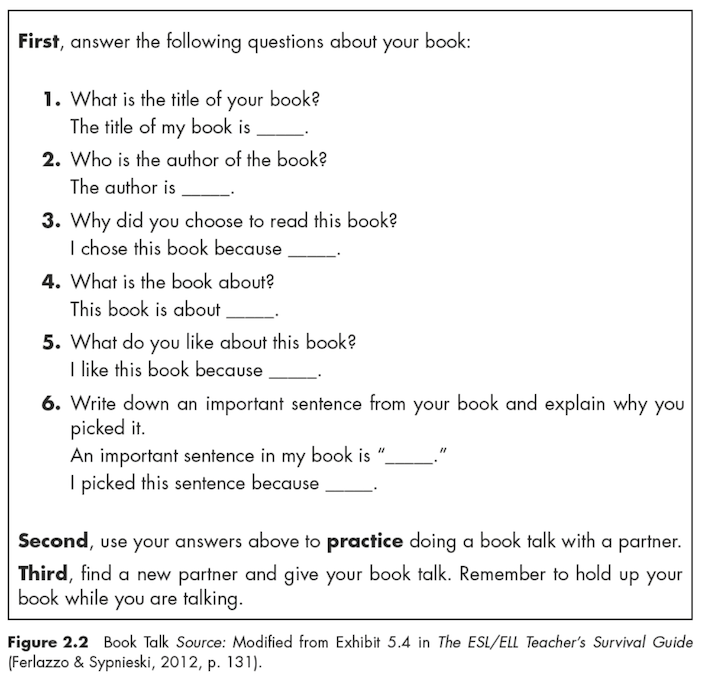
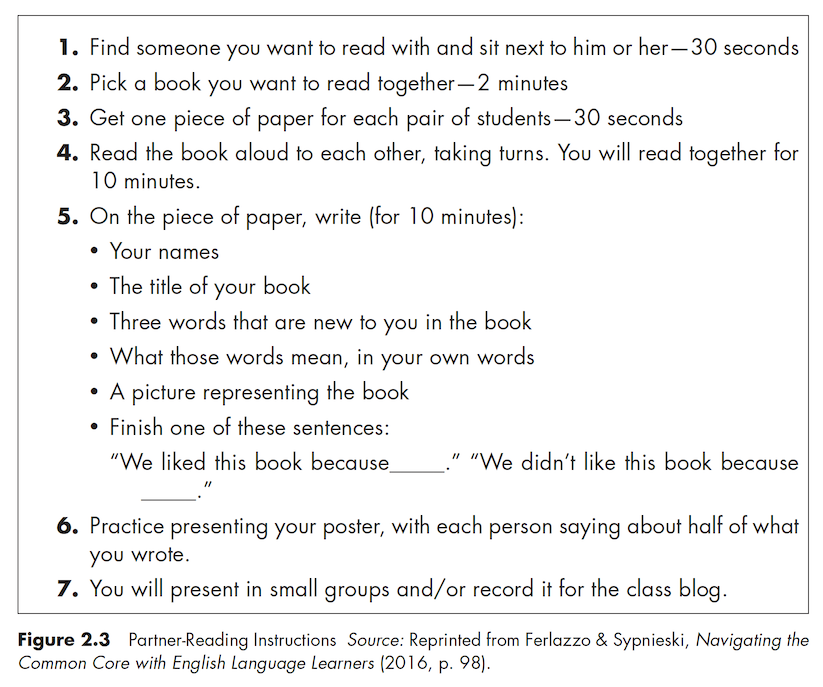
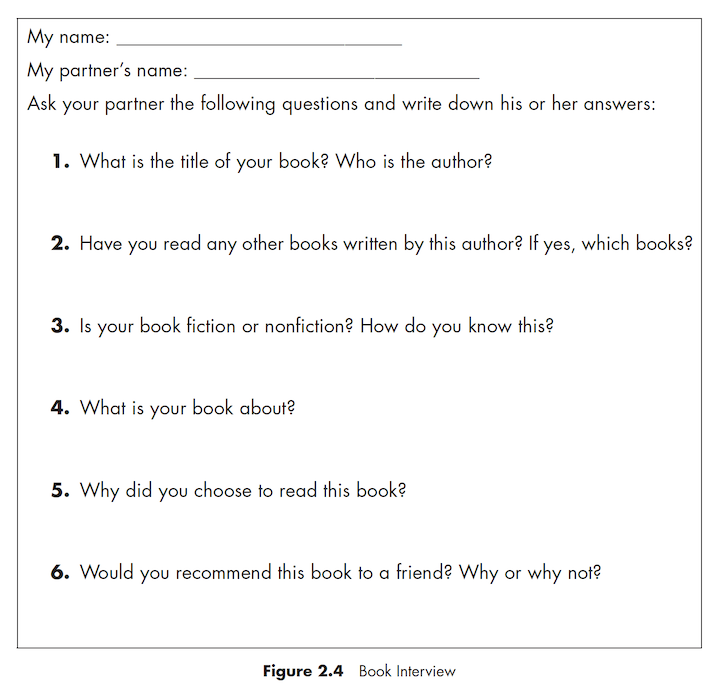


































Great post! I can’t wait to read your new book!
Thanks!